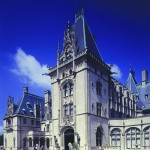 America’s most visited winery isn’t in Napa. It isn’t even in California. Rather, with 600,000 guests annually, the imposing Biltmore Estate can be found in the Blue Ridge Mountains of Asheville, NC. With its driveway measured not in feet, but in miles (glad I don’t have to shovel it), the 1895 mansion was ahead of its time with electric lighting and an elevator and continues to be forward-thinking in its emphasis on being a self-sustaining estate. As part of these efforts, the on-premise dairy was replaced with a winery in 1985.
America’s most visited winery isn’t in Napa. It isn’t even in California. Rather, with 600,000 guests annually, the imposing Biltmore Estate can be found in the Blue Ridge Mountains of Asheville, NC. With its driveway measured not in feet, but in miles (glad I don’t have to shovel it), the 1895 mansion was ahead of its time with electric lighting and an elevator and continues to be forward-thinking in its emphasis on being a self-sustaining estate. As part of these efforts, the on-premise dairy was replaced with a winery in 1985.
In 1997, a belated honeymoon included a visit to the Biltmore, along with a tour and tasting at the winery (in fact, our first winery visit as a couple). By design, our arrival coincided with the Flower Festival, which spanned the full weekend and entailed a myriad of events held at the immense estate. Our attendance at such events meant that our rental car became well acquainted with the lengthy driveway, but each time that the “house” came into view, it took our breath away. Coupled with the lush landscape and numerous gardens designed by Frederick Law Olmstead (of Central Park fame), we departed Asheville with fond memories.
Thus, it was with some delight that I accepted an invitation to meet with Biltmore Estate’s winemaker at a recent lunch in New York City. As you might imagine, growing grapes in North Carolina is not an easy task. The humid climate wreaks havoc in the vineyard, encouraging the growth of mildew and healthy grapes at harvest are not a given. Yet, despite these less than favorable conditions, Bernard DeLille has made wine at the Biltmore Estate for over 25 years.
The Burgundy-trained winemaker responded to an advertisement in 1986, intrigued by the opportunity to make wine in the U.S. Although he was working in Madiran and Jurançon (both in southwest France) at the time, DeLille welcomed the opportunity to produce wines without the rigid constraints of France’s appellation system. Accordingly, he packed up his wife, two children and their belongings and headed to North Carolina to begin his new position. Joining the staff under the direction of Philippe Jourdain, by 1991, he was promoted to the position of winemaker.
Given the challenges that North Carolinian viticulture presents, Biltmore Estate now sources grapes from California for many of its wines. In order to comply with U.S. regulations, wine production takes place in California as well. However, the estate vineyards have not been abandoned; DeLille will continue to make wines at home as well. In this regard, consumers can choose from two Blanc de blanc sparklers – one from North Carolina and the other from Sonoma County’s Russian River Valley. Two still Chardonnays are also similarly produced (Sonoma County and North Carolina). Not surprisingly, their red wine production centers on California.
This new approach to winemaking has provided DeLille with many rewards. Yet, he admits that it can be complicated to keep up with the need to make wine in two different facilities, separated by an entire continent. But, on the whole, DeLille seems to have taken well to the balancing act required. I wish I could say the same of the restaurant’s servers. In clearing the flutes and white wine stemware, both DeLille and I were the recipients of a Chardonnay shower. Luckily, as a veteran journalist, I was wearing black and was consequently, soggy, but not visably stained.
All in all, it was a nice reintroduction to these wines and I appreciated the changes being made in expanding the Biltmore Estate’s range of wines. The new wines should be available in the New York market soon and I would encourage you to seek them out. Or, even better, go join the other 600,000 guests and taste the wines at the estate. It’s truly a great way to spend the weekend!
Biltmore Estate Château Reserve Blanc de Blancs Brut 2008, North Carolina, $30.00
Produced from 100% Chardonnay grapes, this sparkling wine is made in the Traditional Method and receives 12-16 months of lees aging, yielding yeasty, toasty, apple and floral notes on the nose and palate.
Biltmore Estate Blanc de Blancs Brut 2007, California, $25.00
While produced similarly to its North Carolina sister, this sparkler’s grapes are sourced from the Russian River Valley and it spends 18-24 months on the lees. A more pronounced nose offers up riper fruit with apple and pear aromas. On the palate, some yeasty character is evident, but this wine is less toasty and more fruit forward than the other.
Biltmore Reserve Chardonnay 2010, Sonoma County (CA), $20.00
As an unoaked Chardonnay, this wine is all about pure fruit, showing aromas and flavors of pear, apple and citus. Bone dry on the palate with vibrant acidity and a full body, it is an excellent dining partner.
Biltmore Reserve Chardonnay 2010, North Carolina, $15.00
In contrast, this wine is fermented in French and American barrels and approximately 50% of the wine undergoes malolactic fermentation (sharper malic acid is converted to the softer and creamier lactic acid). The nose is rich and buttery with apple notes, while the palate offers apple and a hint of oak.
Biltmore Reserve Cabernet Sauvignon 2010, Alexander Valley (CA), $20.00
A varietally-correct, California Cab, this wine shows lots of black fruit and slight herbal notes, with moderate tannins, balanced acidity and good length.
